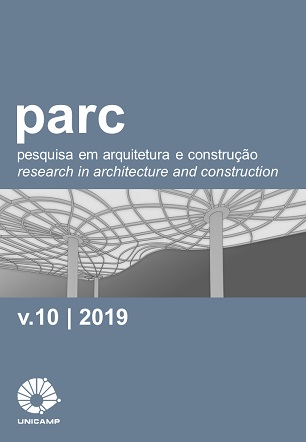Abstract
A vernacular housing alternative widely used by indigenous groups in southern Brazil is based on burying the more significant part of the dwellings and covering it with a vegetated roof. The present study aims to verify the thermal performance of buried and semi-buried test cells when compared to a ground control cell as a bioclimatic strategy. The method is based on the comparison of temperature variations measured inside test cells concerning external and soil temperature measured in Curitiba, PR, during the winter period. The test cells were made on a reduced scale, all with the same dimensions and material specifications. The performance of each test cell was evaluated through the analysis of thermal fluctuations, time lag, differences in temperature, and amplitudes of surface sensors and comfort levels. Data analysis revealed that the buried test cell presented lower thermal amplitude and longer time lag. Regarding the sum of degrees-hours outside the comfort temperature range, the buried test cell obtained the best performance during the winter period. It was also possible to verify that a greater surface area in contact with the soil increases the thermal performance.
References
ABNT - ASSOCIAÇÃO BRASILEIRA DE NORMAS TÉCNICAS. NBR 15220 – Desempenho Térmico de Edificações. Rio de Janeiro; 2005.
ALKAFF S. A. et al. A review of underground building towards thermal energy efficiency and sustainable development. Renewable and Sustainable Energy Reviews, v. 60, p. 692–713. 2016. DOI: https://doi.org/10.1016/j.rser.2015.12.085.
ALVES, A. B. M.; SCHMID, A. L. Cooling and heating potential of underground soil according to depth and soil surface treatment in the brazilian climatic regions. Energy and Buildings, v. 90, p. 41-50. 2015. DOI: https://doi.org/10.1016/j.enbuild.2014.12.025.
ANSELM, A. J. Earth shelters: a review of energy conservation properties in earth sheltered housing. Energy Conservation, v. 31, p.125–48. 2012. DOI:http://dx.doi.org/10.5772/51873
ANSELM, A. J. Passive annual heat storage principles in earth sheltered housing, a supplementary energy saving system in residential housing. Energy and Buildings, v. 40, p. 1214–1219. 2008. DOI: https://doi.org/10.1016/j.enbuild.2007.11.002.
BENARDOS, A. et al. Modern earth sheltered constructions: a paradigm of green engineering. Tunneling and Underground Space Technology, v. 41, p. 46–52. 2014. DOI: https://doi.org/10.1016/j.tust.2013.11.008.
CHMYZ, I. et al. A arqueologia da área do aterro sanitário da região metropolitana de Curitiba, em Mandirituba, Paraná. Curitiba: CEPA, 2003.
DERRADJI, M.; AICHE, M. Modeling the soil surface temperature for natural cooling of buildings in hot climates. Procedia Computer Science, v. 32, p. 615–621. 2014. DOI: https://doi.org/10.1016/j.procs.2014.05.468.
DUFFIE, J. A.; BECKMAN, W. A.; WOREK, W. M. Solar engineering of thermal processes. New York: Wiley, 2013.
FERNANDES, L. C.; KRÜGER, E. L. Thermal performance of a thermal performance of a roof-pond system under subtropical conditions. In: INTERNATIONAL CONFERENCE ON PASSIVE AND LOW ENERGY ARCHITECTURE (PLEA): DESIGN TO TRIVE, 33, 2017, Edinburgh. Proceedings [...]. Edinburgh: PLEA, 2017. v. 3, p. 4039-4045.
GIL, A. C. Como elaborar projetos de pesquisa. 5ª ed. São Paulo: Atlas, 2010.
GIVONI, B. Performance and applicability of passive and low-energy cooling systems. Energy and Buildings, v. 17, p. 177–199. 1991. DOI: https://doi.org/10.1016/0378-7788(91)90106-D.
GIVONI, B. Comfort climate analysis and building design guidelines. Energy and Buildings, v. 18 (1), p. 11-23. 1992. DOI: https://doi.org/10.1016/0378-7788(92)90047-K.
HAIT, J. Passive annual heat storage: improving the design of earth shelters. 3… ed. Chino Valley: Rocky Mountain Research Center, 2013.
KOTTEK, M.; J. GRIESER, C. BECK; B. RUDOLF; F. RUBEL. World map of the Köppen-Geiger climate classification updated. Meteorologische Zeitschrift, v. 15, p. 259–263. jun. 2006. DOI: https://doi.org/10.1127/0941-2948/2006/0130.
KRÜGER, E. L.; LANGE, S. C.; FERNANDES, L.; ROSSI, F. Avaliação do potencial de resfriamento de um sistema tetoreservatório para condições subtropicais. Ambiente Construído, Porto Alegre, v. 16, n. 3, p. 107-125, jul./set. 2016. DOI:http://dx.doi.org/10.1590/s1678-86212016000300095.
LAMBERTS, R.; DUTRA, L.; PEREIRA, F.O.R. Eficiência energética na Arquitetura. 3.ed. Rio de Janeiro, 2014.
PERES, J. G.; BOSCHI, R. S.; SOUZA, C. F. Avaliação de modelos agrometeorológicos que utilizam a amplitude térmica do ar atmosférico para a estimativa das radiações global e líquida. Revista Brasileira de Agricultura Irrigada, v. 10, n. 4, Fortaleza, p. 715 - 725, Jul – Ago, 2016. DOI: https://doi.org/10.7127/RBAI.V10N400344.
ROSSI, Francine Aidie; KRUGER, Eduardo Leite; BRODE, Peter. Definição de faixas de conforto e desconforto térmico para espaços abertos em Curitiba, PR, com o índice UTCI. Ambient. constr., Porto Alegre, v. 12, n. 1, p. 41-59, mar. 2012. DOI: http://dx.doi.org/10.1590/S1678-86212012000100004.
STANIEC, M.; NOWAK, H. Analysis of the earth-sheltered buildings' heating and cooling energy demand depending on type of soil. Archives of Civil and Mechanical Engineering, v. 11, n. 1, p. 221–235. 2011. DOI: https://doi.org/10.1016/S1644-9665(12)60185-X.
TALAMINI NETO, E. Caracterização geotécnica do subsolo de Curitiba para o planejamento de ocupação do espaço subterrâneo. 2001. 223 f. Dissertação (Mestrado em Geotecnia) – Escola de Engenharia de São Carlos, Universidade de São Paulo, São Carlos, 2001.
WEIMER, Günter. Arquitetura popular brasileira. São Paulo: Martins Fontes, 2005.
WEIMER, Günter. Arquitetura indígena brasileira: suas origens remotas. In: FERREIRA, Mario dos Santos; BREGATTO, Paulo Ricardo; KOTHER, Maria Beatriz (Org.). Arquitetura & Urbanismo: posturas, tendências e reflexões. Porto Alegre: Livraria do Arquiteto, 2008. v. 1, p. 27–46.
I accept that PARC Research in Architecture and Building Construction journal perform, on the original file approved for publication, revisions and modifications in orthoghaphic, grammar and standard issues.
I give to PARC Research in Architecture and Building Construction journal the rights of first publication of the revised version of my paper, licensed under the 'Creative Commons Attribution' license (which allows sharing the work with the recognition of first authorship and publication in this journal).


